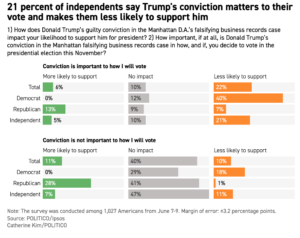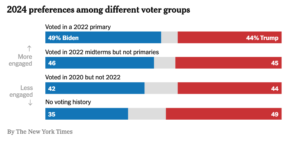June 2024
2024 U.S. Elections Update: Race to the White House
Region: US
Author: Karen A. Tramontano
Polls do not predict the outcome of an election. Elections are determined by who shows up to the ballot box and votes.
Reading and listening to the news about the upcoming 2024 U.S. Presidential election is confusing, if not anxiety producing. Some polls show former President Trump leading, while other polls show President Biden with a slight edge. Which polls one should believe is a constant question, especially from our European friends. The answer is—none of them!
Polls do not predict the outcome of an election. Elections are determined by who shows up to the ballot box and votes. A good example of the movement of the polls is the impact of former President Trump being found guilty on 34 felony counts. Initially, the polls indicated little or no movement. The latest polls demonstrate that after the electorate had some time to process the information, there is an impact on voters who identify as Independent and Republican. The below polling results show this shift:
But what about the other polls that show former President Trump leading nationally? First and foremost, the U.S. does not elect the president based on the national, popular vote. Presidents are elected by the Electoral College, which is a “winner take all” state-by-state election.
As a result, there are, in effect, seven U.S. states that will ultimately decide the outcome of the U.S. Presidential election: Arizona, Michigan, Pennsylvania, Wisconsin, Georgia, Nevada, and North Carolina. Recent polls show either former President Trump in the lead or President Biden in the lead. Which polls are right? The answer is—it depends on which voters are asked, as illustrated below:
Voters who are “likely voters”—those voters are described generally as voters who have voted in recent elections. As the above chart indicates, voters who voted in the 2022 primary election favor President Biden and so too do the voters who voted in the 2022 midterm elections. But voters who have no voting history favor former President Trump.
What does this all mean? Elections are won and lost depending on who shows up to vote. Both the Biden and Trump campaigns understand that they must turn out their voters. For the Biden campaign, they must make sure that voters who always vote also vote in the 2024 presidential election. For the Trump campaign, they must convince voters who have never voted that they must vote in 2024.
While the work of a campaign is challenging, especially when the voters are not happy with on-going wars and inflation, it is slightly less difficult to turn out voters who vote in every election than it is to convince voters who do not vote, to vote in an election.
It is also worth noting that in every election since 2020, which includes the 2022 midterm elections, state legislative elections, state ballot initiatives, and special elections, Democratic party candidates have outperformed Republican party candidates in every race and state ballot initiative.
But as we all know from the 2016 Presidential election, anything could happen. If less engaged voters—those voters who do not typically vote—decide they will vote in the upcoming 2024 Presidential election and if President Biden is unable to hold together the coalition of voters he had in 2020, then former President Trump could win the election. Both campaigns know what is at stake and both are working hard to convince voters that their candidate is the best one to lead the United States of America.


